BLIND TERMITES BUILDING
SKYSCRAPERS
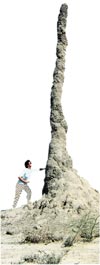 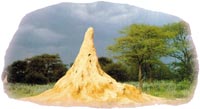 Termites
are as small insects as ants, and they are very skilful. The
nests in these pictures that look like tall towers are built
by these little creatures. But make no mistake: these are
not simple nests; termites build them according to a plan.
Special chambers for the young, fungus production fields and
the queen's chamber are only a few of the sections in a termite
nest. More importantly, there is a special ventilation system.
Termites, whose skins are very thin, need humid air. For that
reason they need to keep the temperature and humidity of the
nest at a certain level. Otherwise termites would die. They
make the air circulate through the nest by means of special
channels and use the water that comes from underground tunnels
they have dug, and thus regulate the temperature and humidity. Termites
are as small insects as ants, and they are very skilful. The
nests in these pictures that look like tall towers are built
by these little creatures. But make no mistake: these are
not simple nests; termites build them according to a plan.
Special chambers for the young, fungus production fields and
the queen's chamber are only a few of the sections in a termite
nest. More importantly, there is a special ventilation system.
Termites, whose skins are very thin, need humid air. For that
reason they need to keep the temperature and humidity of the
nest at a certain level. Otherwise termites would die. They
make the air circulate through the nest by means of special
channels and use the water that comes from underground tunnels
they have dug, and thus regulate the temperature and humidity.
 Have
you realised how hard this process is, and that termites have
to act in a way marked by careful consideration of many things
together? Besides that, what we have mentioned so far is merely
a brief summary of the numerous things that termites do. Have
you realised how hard this process is, and that termites have
to act in a way marked by careful consideration of many things
together? Besides that, what we have mentioned so far is merely
a brief summary of the numerous things that termites do.
Another characteristic of termites
is their defence of the nest, which may be up to seven metres.
Termites are alarmed whenever there is a hole in the walls
of their nest. Hitting their heads against the walls, termites
on watch give warning to all members of the colony. Upon this
warning, larvae are moved to securer places. The entrances
of the chamber where the king and the queen live are blocked
by quickly built walls. The damaged section is surrounded
by soldier termites, which are followed by workers who carry
the material to restore the wall. In a few hours, the destroyed
area is covered with a heap. Then the inner compartments are
constructed. Termites act following a prescribed plan and
each member of the colony carries out its task without causing
any disorder.
That they can do all these things
in quite a short time is evidence of perfect communication
between termites. Yet there is something even more amazing
about the termites that establish such order, build colonies
like skyscrapers and take security precautions to protect
their colonies: they are BLIND.
They see nothing while carrying
out all these tasks. How can these creatures be so skilful
and make such plans?
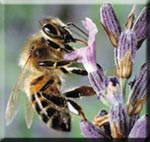 The
answer that evolutionists provide to such questions is that
they happen "by chance". However this answer is not correct.
That is because even a single part of the order in a termite
colony, say the ventilation channels, is sufficient to prove
that such a system cannot come into existence by chance. No
doubt blind termites cannot ensure this perfect order and
cannot have all the work performed so faultlessly. Obviously
they are taught what to do. The
answer that evolutionists provide to such questions is that
they happen "by chance". However this answer is not correct.
That is because even a single part of the order in a termite
colony, say the ventilation channels, is sufficient to prove
that such a system cannot come into existence by chance. No
doubt blind termites cannot ensure this perfect order and
cannot have all the work performed so faultlessly. Obviously
they are taught what to do.
Allah has mentioned some animals
in the Qur'an and urged us to reflect on these examples. For
instance, the honeybee is given as an example in Surat an-Nahl.
We are informed in the verse that bees that produce honey
for us are taught what to do by our Lord. The verses are:
Your Lord revealed
to the bees: "Build dwellings in the mountains and the trees,
and also in the structures which men erect. Then eat from
every kind of fruit and travel the paths of your Lord, which
have been made easy for you to follow." From inside them comes
a drink of varying colours, containing healing for mankind.
There is certainly a Sign in that for people who reflect.
(Surat an-Nahl: 68-69)
Just like the bees referred
to in the above verses, termites live in the way Allah teaches
them and reveals to them. It is our Lord Who creates perfect
communication between these sightless creatures, teaches them
what to do and makes each one of the millions of termites
in a colony perform its task.
|
Mankind! remember Allah's
blessing to you. Is
there any creator other than Allah providing
for you from heaven and earth? There is no
god but Him. So how have you been perverted?
(Surah Fatir: 3)
|
SECURITY MEASURES OF ANIMALS
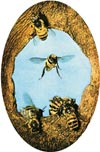
 The birds in the pictures build
nests so as to prevent their enemies from entering.
Termite nests, such as the tower-like one to the side
and the mushroom-like one above, are as strong as castles.
The birds in the pictures build
nests so as to prevent their enemies from entering.
Termite nests, such as the tower-like one to the side
and the mushroom-like one above, are as strong as castles.
|
It is among the miracles in
nature that living creatures take precautions to protect themselves.
Many creatures have the capability to estimate potential hazards
and to invent various security methods. For instance, the
termites that we mentioned build the walls of their colonies
so thick and hard that they can hardly be destroyed even with
a pickaxe. Weaverbirds build the entrance of their nests in
such a way as to prevent snakes, their main enemies, from
entering. Some spiders have special chambers in their nests
in which other animals that have somehow entered the nest
are confined.
Beehives also operate special
protective measures. The bees that are employed to stand guard
over the hive do not let anyone in other than members of the
colony. When a guardian is away, another worker bee comes
to the entrance of the hive and takes over the watch. Moreover
these guardian bees carry out this task at the risk of their
own lives.
 Building their dams in streams,
beavers stop the flow of water and construct wonderful
lodges for themselves.
Building their dams in streams,
beavers stop the flow of water and construct wonderful
lodges for themselves. |
Beavers build their lodges underwater.
In order to enter, one has to pass through a secret tunnel
known only by the beaver that built that lodge. At the end
of the tunnel, there is a chamber where beavers live together
with their offspring.
Even these examples are sufficient
for us to understand that there is intelligence in the way
living creatures act and that they employ very effective methods
to protect themselves. Besides, you may have noted that the
enemy of a species may be another species. However, all creatures
know their enemies very well and take elaborate precautions
against them. It is quite surprising that a termite or a bird,
despite the fact that it lacks advanced intellectual functions,
can know the features of another creature.
To comprehend it better, think
about yourself. Can you understand at first sight the characteristics
of an animal that you do not know and have not seen before?
Can you know what it feeds on, how it hunts and what it fears?
Of course you cannot. You need a book to read and to get information
about that creature or someone to tell you about its attributes.
But how can animals have information about other creatures?
Might they have found out who their enemies are and then conducted
a study of their behaviour and hunting methods, upon the basis
of which they have developed suitable precautions? Certainly
not. No animal has the intellectual capabilities and talent
to do research. Besides, it would also be unreasonable and
nonsensical to think that animals gathered information about
their enemies by chance, because failing in the first attempt
would mean death.
Undoubtedly it is Allah Who
determines the security measures that animals use and makes
them act as necessary. The fact that not only the animals
we see around us, but all living creatures in the world behave
in the same intelligent way points to the infinite wisdom
and power of our Lord.
COMPASS IN THE ANT'S EYE
 We
need guides to show us the direction when we travel to another
country or another city. In particular, when we do not know
the place we are going to, we definitely must have a compass
and a map. Map shows us where we are and the compass shows
us which way to go. We find the way by using these tools and
consulting other people so we do not get lost. Have you ever
wondered how other creatures find their way? Have you ever
thought how an ant seeking food in the desert returns to its
nest? We
need guides to show us the direction when we travel to another
country or another city. In particular, when we do not know
the place we are going to, we definitely must have a compass
and a map. Map shows us where we are and the compass shows
us which way to go. We find the way by using these tools and
consulting other people so we do not get lost. Have you ever
wondered how other creatures find their way? Have you ever
thought how an ant seeking food in the desert returns to its
nest?
Black desert ants inhabiting
the Mediterranean coasts of Tunisia are among those creatures
who build their nests in the desert. These ants are very good
at finding their way in the vast desert and getting back to
their nests without the help of a compass or a map.
As the sun rises, temperatures
in the desert reach up to 70oC (158oF).
The ant leaves its nest to find food in the heat of the day.
Frequently halting and turning around itself, it follows a
devious route within an area that may be 200 metres (655 feet)
away from the nest. You may see this route on the map. But
do not think that the ant will get lost because of these zigzags.
Once it finds a source of food, the ant follows a straight
course and returns to the nest. With respect to their sizes,
this journey of the ant may be compared to a man's returning
to his starting point taking a straight course after wandering
35-40 kilometres (22-25 miles) away from that point in the
desert. How is it that an ant successfully does a task that
is virtually impossible for a human?
It cannot be that the ant finds
its direction by looking at objects. Signs and way-marks such
as trees, rocks, rivers or lakes which help one find the way
are quite rare in the desert. There is only sand all around.
Even if there were such signs, it would not make any difference
since it is not possible for an ant to keep these signs in
mind, to memorise where they are and to use them while finding
its way. Thinking about it this way, one can better understand
the significance of the task that the ant performs. The ant
can perform this difficult task thanks to the special body
structure it has been given.
There is a special direction-determination
system in the ant's eyes. This system that Allah placed in
the ant's eyes is more advanced than mechanical devices that
determine direction. Being able to perceive some rays that
we cannot, the ant can determine directions and know where
north and south are. Thanks to this ability, it is not difficult
at all for the ant to estimate where its nest is and to return
to it.
|
(Do they) worship, instead
of Allah, things that
have no control over their provision from the
heavens or earth in any way, and are themselves
completely impotent? Do not try to make
metaphors for Allah. Allah knows and you
do not know.
(Surat An-Nahl: 73-74)
|
 Human
beings have lately become aware of the characteristics of
light. However the ant has known and used a characteristic
of light, which was unknown to human beings, since it was
born. Certainly such a perfect structure as the eye of this
ant cannot be attributed to random coincidences. The eyes
of the ant must have been so since it came into existence.
Otherwise the ant could not return to the nest in the desert
heat and could not survive. Indeed, eyes of all desert ants
have been equipped with this system since the first day they
came into existence. Allah, the All-Knowing, created these
eyes for them. Human
beings have lately become aware of the characteristics of
light. However the ant has known and used a characteristic
of light, which was unknown to human beings, since it was
born. Certainly such a perfect structure as the eye of this
ant cannot be attributed to random coincidences. The eyes
of the ant must have been so since it came into existence.
Otherwise the ant could not return to the nest in the desert
heat and could not survive. Indeed, eyes of all desert ants
have been equipped with this system since the first day they
came into existence. Allah, the All-Knowing, created these
eyes for them.
THE MARVELLOUS CO-OPERATION
OF THE ANT AND THE BIRD
  There
are microbes everywhere that threaten our health and cause
diseases. These microbes are a danger to other living creatures
as well as human beings. Therefore these creatures, too, need
to protect themselves just as we do. When living creatures
are observed, we see that they use some methods to protect
themselves against microbes. For instance, ants produce a
kind of acidic substance that incapacitates microbes. They
apply this acidic substance to their bodies and to the walls
of their nest. In other words, they know that not only they
themselves but also the nest they live in should be purified
of microbes. There
are microbes everywhere that threaten our health and cause
diseases. These microbes are a danger to other living creatures
as well as human beings. Therefore these creatures, too, need
to protect themselves just as we do. When living creatures
are observed, we see that they use some methods to protect
themselves against microbes. For instance, ants produce a
kind of acidic substance that incapacitates microbes. They
apply this acidic substance to their bodies and to the walls
of their nest. In other words, they know that not only they
themselves but also the nest they live in should be purified
of microbes.

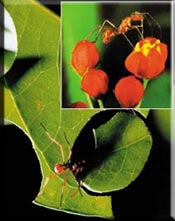 Ants, which are very tiny creatures,
are aware that microbes are harmful to them and take
the appropriate precautions. They produce a kind of
acid that deactivates microbes. Allah inspires ants
to do this.
Ants, which are very tiny creatures,
are aware that microbes are harmful to them and take
the appropriate precautions. They produce a kind of
acid that deactivates microbes. Allah inspires ants
to do this. |
How is it that a little ant
can know to act so intelligently? No doubt the ant's intellectual
power is not enough for that. An ant can know neither what
a microbe is nor that it should protect itself from it. The
ant should have first analysed the microbe and t+hen found
the substance to render it harmless. But how could it have
determined this substance?
Let's think together.
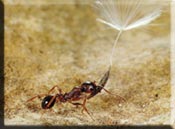 People
are inoculated against specific microbes, but these vaccines
are prepared in laboratories as a result of much research
and experiment. Moreover, experts perform this research, for
otherwise the vaccine would not be of any use, and could even
be harmful. Ants, on the other hand, do not have such knowledge
and have not been trained. They cannot possibly go to a laboratory
and do research. It is unreasonable even to think such a thing.
Obviously ants are born into the world knowing all these things
that they do. People
are inoculated against specific microbes, but these vaccines
are prepared in laboratories as a result of much research
and experiment. Moreover, experts perform this research, for
otherwise the vaccine would not be of any use, and could even
be harmful. Ants, on the other hand, do not have such knowledge
and have not been trained. They cannot possibly go to a laboratory
and do research. It is unreasonable even to think such a thing.
Obviously ants are born into the world knowing all these things
that they do.
This knowledge is taught to
the ant by a superior Being: Allah, the Lord of all the worlds
and the Creator of everything, reveals to the ant how to protect
itself from microbes.
 Now
let's take birds as another example of living creatures that
should be protected against microbes. Microbes disturb birds
too, but birds do not have a system in their bodies to produce
protective substances as ants do. Consequently birds have
found a different but equally practical solution to this problem.
They go to and lie upon an ant's nest, and wait for the ants
to wander through their feathers. Ants that search for food
stroll among the bird's feathers and the substance that kills
the microbes is smeared on the bird's feathers as they do
so. Thus, the bird is purified of microbes. How do birds know
that ants produce such a substance and that this substance
will remove microbes from their bodies? Now
let's take birds as another example of living creatures that
should be protected against microbes. Microbes disturb birds
too, but birds do not have a system in their bodies to produce
protective substances as ants do. Consequently birds have
found a different but equally practical solution to this problem.
They go to and lie upon an ant's nest, and wait for the ants
to wander through their feathers. Ants that search for food
stroll among the bird's feathers and the substance that kills
the microbes is smeared on the bird's feathers as they do
so. Thus, the bird is purified of microbes. How do birds know
that ants produce such a substance and that this substance
will remove microbes from their bodies?
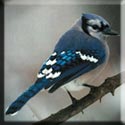  People
have discovered that ants have such a protective system only
after much research. Many people other than those who have
expert knowledge about animals are still not aware of it.
Probably you too, have just learnt about it here. Birds, however,
have known this feature of ants from the moment they were
born. Moreover, although there is nobody to teach them how
to do it, they can use ants to be cleansed of microbes. People
have discovered that ants have such a protective system only
after much research. Many people other than those who have
expert knowledge about animals are still not aware of it.
Probably you too, have just learnt about it here. Birds, however,
have known this feature of ants from the moment they were
born. Moreover, although there is nobody to teach them how
to do it, they can use ants to be cleansed of microbes.
The fact that birds can know
about a substance produced in an ant's body and can know how
to make use of it leads us to a single fact: Allah teaches
this information to both creatures. Allah has revealed that
every being is under His command :
… No, everything
in the heavens and earth belongs to Him. Everything is obedient
to Him. (Surat al-Baqara: 116)
|
And in your creation and all
the creatures He
has spread about there are Signs for people
with certainty.
(Surat al-Jathiyya: 4)
|
LITTLE ENGINEERING BIRDS
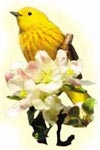 You
certainly must have seen birds' nests built on trees or on
tops of buildings, and sometimes on a corner of a balcony.
These are merely the nests of the few bird species that you
know. But so many bird species live in the world and they
build so many different types of nests that one should really
reflect on this. You
certainly must have seen birds' nests built on trees or on
tops of buildings, and sometimes on a corner of a balcony.
These are merely the nests of the few bird species that you
know. But so many bird species live in the world and they
build so many different types of nests that one should really
reflect on this.

Birds build their nests in safe places especially chosen
by them. |
Before all other considerations,
birds build their nests so that they blend in with their natural
environments. Let us consider birds of the shoreline. These
birds build their nests on the surface of the water and the
nest does not sink. The materials used and the shape of the
nest are all particularly designed. So, even if the water
level rises, neither the nest nor the offspring are damaged.
These animals have innate capabilities to build their nests
and have no need of training. They could not have possibly
learnt such a task over time; if they had tried to do it by
trial and error, the nest would have sunk as the water rose.
However such a thing never happens because all shoreline birds
have built their nests in the same way since the first day
they appeared.
Some birds living in swamps
build the walls of their nests high so that the eggs do not
fall out because of the wind. How is it that this bird, which
carefully protects its egg, knows about the risk of eggs falling
out and being broken? We see here that the bird takes a wise
precaution.
Another bird species living
in arid areas builds its nest among the bushes and not on
the ground. The reason why it does so is the difference in
temperature: the temperature among the bushes is ten degrees
less than on the ground. Most of us do not know about the
temperature difference between the ground and bushes, and
that there is a difference between them. These birds, however,
know it and protect themselves and their young from intense
heat by building their nest in the coolest place.
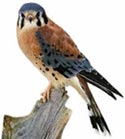 Have
you ever wondered how birds, which lack consciousness and
intellect as we understand them, can consider such delicate
details? Have
you ever wondered how birds, which lack consciousness and
intellect as we understand them, can consider such delicate
details?
These behaviours of birds could
be compared to those of engineers who have gone through years
of education and training in their fields. While building
a house, engineers consider details such as the strength of
the building, materials to be used and location; only then
can construction begin. As you have seen in the above examples,
birds also build their nests according to a plan. But they
do not need any tools or education. They act by the inspiration
of Allah and carry out their tasks easily. These birds and
what they perform are evidence of Allah's perfect creation.
It is surely the All-Knowing Allah Who inspires them to do
everything they do.
|
Everything in the heavens
and everything in
the earth belongs to Him. Allah is the Rich
Beyond Need, the Praiseworthy.
(Surat al-Hajj: 64)
|
THE HEATING SYSTEM OF THE
WINTER MOTH
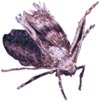 When
winter comes, many insect species inhabiting cold regions
of the world die from cold or lack of food. That is because
insects are delicate creatures, but there are some exceptions
to this rule. For example, owl moths look like butterflies
and at first sight seem very delicate. In reality, however,
they are strong enough to survive tough winter conditions.
Therefore these moths are also called "winter moths". When
winter comes, many insect species inhabiting cold regions
of the world die from cold or lack of food. That is because
insects are delicate creatures, but there are some exceptions
to this rule. For example, owl moths look like butterflies
and at first sight seem very delicate. In reality, however,
they are strong enough to survive tough winter conditions.
Therefore these moths are also called "winter moths".
Like butterflies, a winter moth
has two wings and a trunk to which these wings are joined.
In order for this moth to fly, the temperature of its thorax
to which its wings are affixed should be 30oC (86oF).
But the temperature where they live is usually 0oC
(32oF) and even drops below minus degrees from
time to time. How could winter moths survive such cold? What
prevents them from freezing when they are motionless and what
enables them to fly in cold weather?
This moth species is created
together with a special heating system that enables it to
live under winter conditions. This system consists of several
complementary features.
  Before
flight winter moths continuously tense the main muscles that
are connected to the wings and make their wings quiver. The
rapid quivering of the wings leads to an increase in the temperature
of the insect's thorax. Thanks to this increase, the temperature
of the thorax may rise from 0oC (32oF)
to 30oC (86oF) or even more. However,
this is only one of the features that the moth needs to survive.
In order to fly it is not sufficient for the winter moth merely
to increase its body temperature. That is because the difference
between the temperatures of the insect's body and of the atmosphere
will result in loss of heat. In the same way as a glass of
hot tea cools after a while, the moth's body will also cool.
Therefore it will not help even if the moth keeps its wings
quivering. In order for the winter moth to fly and thus to
live, another method is required to maintain the heat it has
produced. This need is also met by a special structure that
Allah created in the moth's body. Moths are covered with dense
scales that reduce heat loss. Scientists have determined after
research that a moth without scales cools twice as fast as
those with scales. Before
flight winter moths continuously tense the main muscles that
are connected to the wings and make their wings quiver. The
rapid quivering of the wings leads to an increase in the temperature
of the insect's thorax. Thanks to this increase, the temperature
of the thorax may rise from 0oC (32oF)
to 30oC (86oF) or even more. However,
this is only one of the features that the moth needs to survive.
In order to fly it is not sufficient for the winter moth merely
to increase its body temperature. That is because the difference
between the temperatures of the insect's body and of the atmosphere
will result in loss of heat. In the same way as a glass of
hot tea cools after a while, the moth's body will also cool.
Therefore it will not help even if the moth keeps its wings
quivering. In order for the winter moth to fly and thus to
live, another method is required to maintain the heat it has
produced. This need is also met by a special structure that
Allah created in the moth's body. Moths are covered with dense
scales that reduce heat loss. Scientists have determined after
research that a moth without scales cools twice as fast as
those with scales.
These are some of the mechanisms
in a winter moth that protect it from cold. The features mentioned
above must have existed since this moth species came into
being. Otherwise, the moth would die of cold and this species
would be extinct. One does not need to reflect at great length
to understand that it is not a coincidence that only those
species inhabiting cold regions possess these features that
make them different from all other moths. Taking all kinds
of measures to enable these creatures to survive in cold,
Allah introduces Himself to us. It is related in a verse that
Allah knows where all creatures live:
There is no creature
on the earth which is not dependent upon Allah for its provision.
He knows where it lives and where it dies. They are all in
a Clear Book. (Surah Hud: 6)
Such features in living creatures
enable us to grasp Allah's power and artistry, and increase
our faith in and love for our Lord. Communicating the amazing
information you read to others, you may also be the means
to increase other people's faith in Allah.
HOW DO SALMON FIND THEIR
WAY?
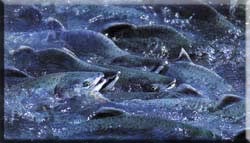 You
are mistaken if you think that migration is peculiar to birds.
In fact, there are many migratory species on land and in sea.
In this section, the adventure of salmon, a migratory fish
species, will be examined. You
are mistaken if you think that migration is peculiar to birds.
In fact, there are many migratory species on land and in sea.
In this section, the adventure of salmon, a migratory fish
species, will be examined.
 Salmon
are born into the world as they hatch from eggs the females
of the species lay in the river. They grow and hunt in this
place for several weeks after which they start to advance
down the river. During this journey towards the sea, they
encounter dams and polluted water, and try to avoid dangers
such as bigger hunting fishes. Having overcome all these and
reached the sea, they spend several years there. Once they
mature enough to spawn, they swim back to the fresh water. Salmon
are born into the world as they hatch from eggs the females
of the species lay in the river. They grow and hunt in this
place for several weeks after which they start to advance
down the river. During this journey towards the sea, they
encounter dams and polluted water, and try to avoid dangers
such as bigger hunting fishes. Having overcome all these and
reached the sea, they spend several years there. Once they
mature enough to spawn, they swim back to the fresh water.
The point at which salmon aim
to arrive is the place they were born. But make no mistake:
it's not a short distance. The distance that the fish needs
to cover to get to the destination may sometimes be 1,500
km (930 miles), which means a demanding journey of months.
There are many obstacles that the fish has to overcome during
this journey.
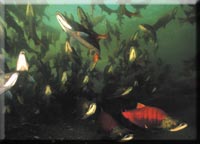 The
first, and maybe the most important problem that needs to
be solved is to find where the river down which the fish swam
during its first journey empties into the sea. Based on this,
the fish will determine the return route to follow. Amazingly,
none of the salmon makes a mistake and they all find the river
right first time. The
first, and maybe the most important problem that needs to
be solved is to find where the river down which the fish swam
during its first journey empties into the sea. Based on this,
the fish will determine the return route to follow. Amazingly,
none of the salmon makes a mistake and they all find the river
right first time.
Entering the stream, the salmon
starts to steadfastly swim against the current. This time
its task is harder because, whereas it could easily pass down
waterfalls with the assistance of the current the first time,
it has to climb up over them this time. What the salmon in
this picture intends by leaping upriver is to reach the place
where it was spawned. During this journey the salmon may need
to swim through shallow waters that leave its upper fin above
water. These shallow waters are full of birds, bears and many
wild predators.
The difficulties that the salmon
has to overcome are not limited to these. Recall that it hatched
from the egg in a branch of a river, in a quite inner part
of the land. In order to reach that point, it has to go the
correct way when the river forks into branches. Salmon do
not make any mistake in these choices and they always follow
the correct stream.
Now suppose that you were born
and had grown up in a house in a city. Then one day you left
your house, travelled for days and came to a place 1,500 km
(930 miles) away from home. Years passed and you desired to
return to your place of birth. Do you think that you could
possibly remember streets that you passed only once? While
no human being could, salmon can and they always find their
way faultlessly.
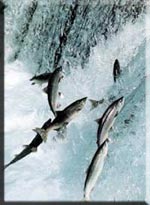 There
have been various studies to understand how salmon make this
exceptional journey. It has been concluded that salmon find
their way by use of "smell". There
have been various studies to understand how salmon make this
exceptional journey. It has been concluded that salmon find
their way by use of "smell".
Thanks to its ingeniously structured
nose, a salmon can pursue a scent in the water to its source
just as a hound does. In fact, every current has a distinctive
smell. The young salmon records all the smells during its
journey and returns home by recalling these smells.
How does this extraordinary
thing happen? How could every salmon find its way correctly?
Why do all salmon try to return to their place of birth, risking
their lives, leaping waterfalls and confronting wild animals?
What is more, they do not do all these things for themselves
but simply in order to deposit their eggs in these waters.
There is only one answer to
these questions: Allah, the All-Knowing, created the salmon
and the systems that enable them to find their way. Like all
creatures, salmon act by the inspiration they receive from
Allah and they manifest the Lord's excellent creation.
Among the evidence that refutes
the theory of evolution is that salmon cover thousands of
kilometres and risk their own lives to spawn.
Evolutionists claim that all
creatures are always in a struggle with each other and that
only the strong survive at the end of this struggle. However,
there is a co-operation among living creatures contrary to
evolutionists' assertions. Animals risk their own lives for
their offspring. Besides, as you will see in the examples
given in the following pages, there are different species
that associate with and benefit each other. The salmon is
merely one of the creatures that display self-sacrificing
behaviour for their offspring. Salmon that migrate and manage
to reach the place to spawn, which are very small in number,
will die soon after they produce their spawn. Yet they never
give up their journey. Such self-sacrificing behavioural patterns
cannot by any means be explained by the theory of evolution.
The fact is evident. Allah created salmon and these creatures
behave in the way that Allah inspires in them. People who
use their intellect take lessons from such behaviour of animals.
Allah reminds us to do so in a verse :
There is no creature
He does not hold by the forelock... (Surah Hud: 56)
|
